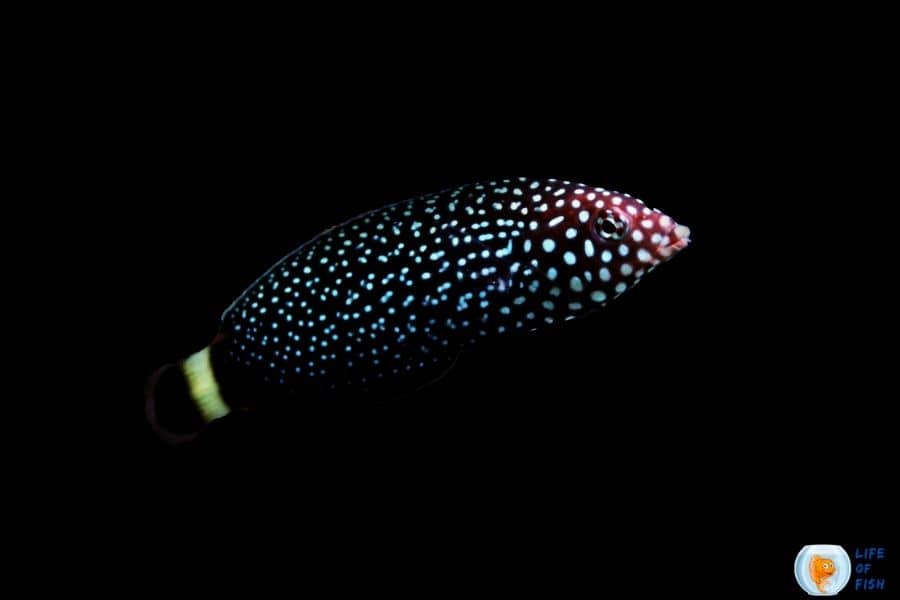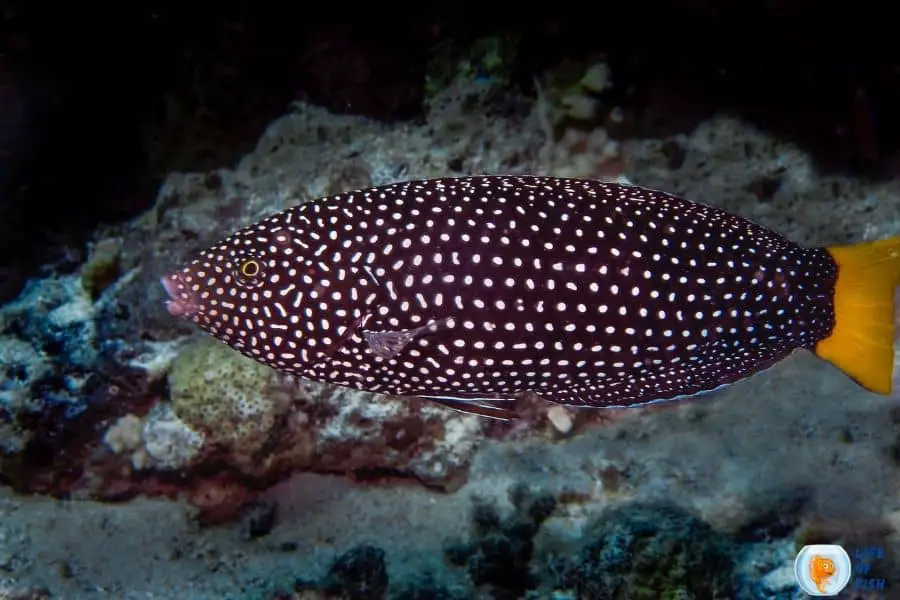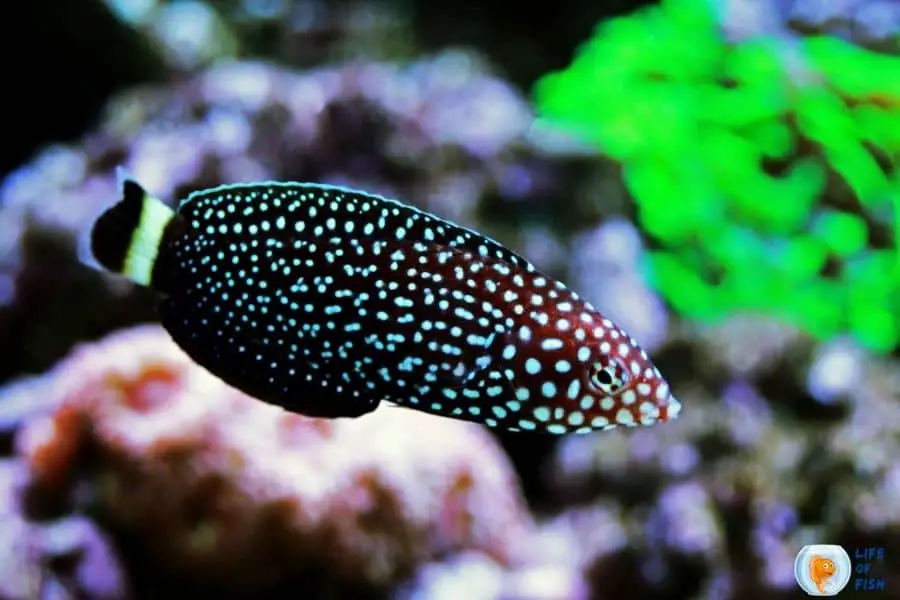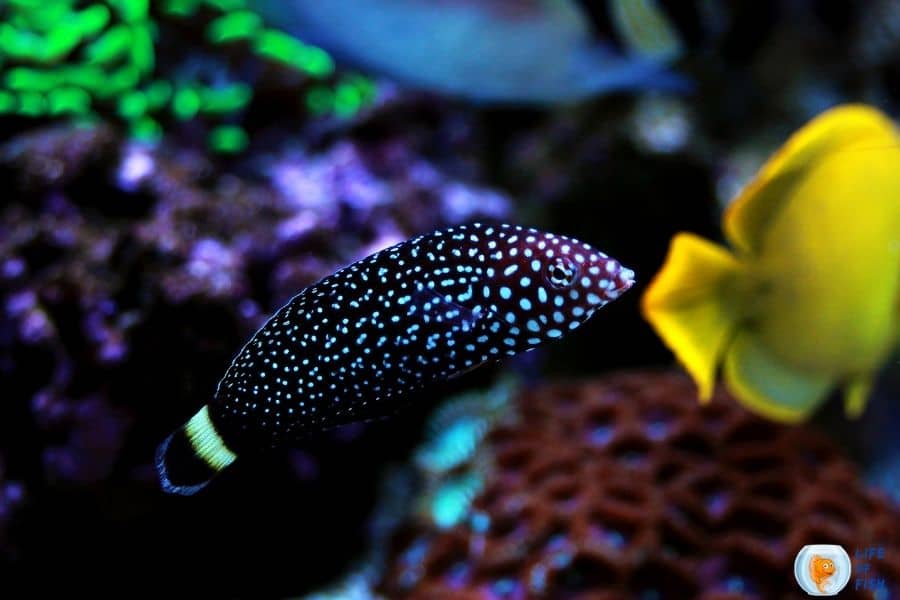If you ask me what is the most unusual fish I have ever seen, spotted wrasse would include in my first 10 choices. I must say they are not different from any other fish, but their color pattern is a wonderful creation of nature.
As I found spotted wrasse is an uncommon marine fish species. Actually, if you can keep this fish in your reef or marine tank for a long time, it will be a great achievement.

One Look Care Guide
Jump To
- 1 One Look Care Guide
- 2 What is the specialty of this fish?
- 3 More about Spotted Wrasse?
- 4 How Big Does Spotted Wrasse Get?
- 5 Is Spotted Wrasse Aggressive?
- 6 Spotted Wrasse Behavior
- 7 How Long Do Spotted Wrasse Live?
- 8 Spotted Wrasse Care
- 9 Spotted Wrasse Breeding
- 10 Feeding behavior of Spotted wrasse
- 11 Spotted wrasse tank mates
- 12 Related questions
| Scientific name | Anampses meleagrides |
| Common names | Spotted wrasse Yellowtail tamarin Yellowtail wrasse Sand reef wrasse Yellowtail tamarin wrasse Speckled wrasse white-spotted wrasse Dotted wrasse |
| Care level | Bit difficult. It is recommended for experts |
| Native to | The Indian Ocean from the Red Sea and East Africa to the western Pacific Ocean to Samoa and the Tuamoto Islands and north to Japan. |
| Color | Black body with white spots, bright yellow color tail |
| Tank size | 300 L 79 US gal |
| Preferred temperature | 24 to 28 Celsius 75 to 82 Fahrenheit |
| Other water parameters | Ph level- 7.5 to 8.5 Water hardness – dKH 8 to 12 |
| Preferred salinity | 1.020 to 1.025 |
| Growth rate | No exact growth rate |
| Temperament | Non-aggressive But show aggressiveness towards small fish species |
| Recommended tank mates | Peaceful fish species that is the similar size or larger than spotted wrasse. But not too large. |
| Preferred food | Pyramide snails Sea urchins Flatworms brine shrimps and mysidworms |
| Feeding frequency | 2 to 3 times per day |
| breeding | Do not breed in captivity |
| Reef compatible | Yes |
What is the specialty of this fish?
Actually, not like other wrasses, they are challenging to keep in captivity. That’s why this fish is recommended for only experts. But do not worry. You can accept this challenge and start from this point. But be mindful to follow the guidelines.
Discover the beauty and complexity of wrasse fish in our comprehensive article!” – wrasse fish
More about Spotted Wrasse?
They are beautiful marine fish. Scientifically, this fish can be known as Anampses meleagrides. Sometimes you can hear other names that are used to call the Spotted wrasse, and these common names are Yellowtail tamarin, Yellow tail tamarin wrasse, and Yellowtail wrasse. They belong to the family Labridae.
Yellowtail tamarin is a rare species in the aquarium industry due to its unique appearance. They have a white-spotted body and distinct yellowtail. If it is explained more, Spotted wrasse has a flat black color body covered with varying-sized white dots. Also, the bright yellow color tail adds more stunning vibrant to this fish species. However, you can rear this saltwater fish with corals without any issue because they are reef safe.
So, now I will answer where we can find this fantastic marine creature. Generally, they are native to several oceans. So, it can be concluded that the Indian Ocean, the Red Sea. Also, they are found in East Africa to the western Pacific Ocean to Samoa and the Tuamoto Islands and north to Japan. Generally, they live in coral reef habitats at depths of 3 to 60 m or 9.8 to 196.9 ft. Anyhow, they are excellent addition to your reef tank due to its unique look.
However, the majority’s opinion is this species is difficult to rear due to its feeding behavior. But if you are an expert, you can keep them easily. So, you can start to be an expert on spotted wrasse after you read this article!
How Big Does Spotted Wrasse Get?
Generally, they can get 8.5 inches in size. But there are reported cases that this fish species had reached about 9 inches in length. So, is it a miracle? No, it is a result of love and care. It means the proper care will cause you to reach the ideal level of your fish, including age.
Is Spotted Wrasse Aggressive?
Generally, this fish is non-aggressive. Simply this fish species is peaceful. Similarly, spotted wrasse does not disturb other tankmates in the same tank. Also, this fish species is reef-safe. But there is an exceptional case. Normally, well-grown adult fish is pretty large, about 8.5-9 in size.
So, they do not work well with small fish species smaller than them. At this time, they can show aggressive behaviors towards these smaller ones. Therefore. Do not try to choose small fish species with spotted wrasse in the same tank. It can make trouble.

Spotted Wrasse Behavior
Generally, we can notice that they live as a group. They do not disturb their tankmates. It means you can rear any number of spotted wrasses if you have a proper space. But this fish species is pretty hard to keep in captivity. So, my recommendation firstly does not to go for large numbers.
Also, these fish swim actively around the corals or tank, searching for food. However, spotted wrasse is shy and fearful fish species. That’s why, when they feel scared or unsafe, they hide in the sand. So, you have to create an environment where they feel safe.
Also, do you believe me if I said that spotted wrasse sleep burying itself in the sand? Yes, it is. Actually, this behavior is unique for many species of wrasses. Also, they are jumpers. This can happen frequently. The bad thing is they can jump out of the aquarium. Further, they active in the middle and depth of the aquarium. They do not prefer to swim in the upper part of the tank or closer to the surface.
How Long Do Spotted Wrasse Live?
Generally, they have the ability to live up to 10 to 12 years under excellent care. The water condition, tank setup, food availability, and tank mates directly influence their lifespan.
Special Note: It is best to introduce spotted wrasses in their juvenile stage. Because it will increase the survival rate. Further, it is easy to adjust them to a new environment when they introduce at an early stage of their life.
Spotted Wrasse Care
Caring for them a bit difficult. But it is not impossible! You can provide the same conditions as a natural habitat to keep them alive. Therefore, further reading is vital for you!
Tank Size
Spotted wrasses need a pretty large space to live happily. So, I recommended having at least a 300L/ 66 lmp gal or 79 US gal. However, some hobbyists keep spotted wrasses fish in 60 gallons tanks. But it is better to go with a tank that has more space for your fish.
Because adequate space directly connects to create healthy fish. On the other hand, when you choose a tank, you should consider the other fish species and corals that you wish to keep in the same aquarium.
How Many Spotted Wrasse Should Be Kept Together?
Generally, when it turns to wrasses, most people tend to keep one male fish with one or more female fish. Because most male wrasse fish species show aggressive behavior towards the same species of male fish. However, spotted wrasses peaceful fish species than others. Hence you can keep this fish alone too.
The spotted wrasses live in the wild alone or in pairs. Therefore, I recommend starting with one or a couple of spotted wrasses. Then you can increase the number of fish by considering their behaviors and tank space. However, some hobbyists share their experience, and some of them already rear 3 or more spotted wrasses in the same tank.
Tank Setup
So, we already know the minimum tank size you should have to rear spotted wrasses. Another important thing is how we set up the spotted wrasses tank properly. As I already mentioned that the living environment should be ideal and identical to their natural habitat.
Thus, it will reduce the large percentage of the risk caused to killing your fish. So, generally spotted wrasses live in coral areas in the wild. Therefore, it is better to add plenty of live rocks, rocks, and corals to your tank.
So, this fish species is ideal for your reef aquarium. Because spotted wrasses have a special ability. Do you know what it is? They practice their feeding behavior in the wild. It means they eat small invertebrates that grow on these live rocks. So, if you add them to the reef aquarium, they can continue this behavior. However, when you decorate spotted wrasses aquarium, do not forget to leave some space because they need plenty of open space to swim and hide.
Another important matter is what is the most suitable substrate for your spotted wrasse tank.? Absolutely sand is the one and only solution because sand substrate will allow your fish to burrow into it. This behavior can be seen due to two main situations. One is when they are sleeping, and another is when they feel safe or in danger.
Therefore, you should add fairly fine and smooth (not sharp) sands. So, when you set up the tank, you should create about a 2 inches or 5 cm deep sand bed. However, if you like to bear bottom and if you should need both of two, you have the option.
You can add a Tupperware with a 2 inches deep sand bed to accommodate spotted wrasses in your bare bottom tank. Further, I mentioned above that the spotted wrasses are good jumpers. But if they jump out of the aquarium, they may die.
Therefore, the only option is to cover the open space at the top of the tank. Because you cannot stop their natural behaviors, it is better to go for a tight-fitting canopy or screen cover. Moreover, it is known that the spotted wrasses jump through the smallest of holes in the canopy. So, you should be highly concerned about this too!
Water Quality Condition
Water quality is another vital factor related to the fish’s living environment. Also, you should maintain the water parameters to the ideal level to keep your spotted wrasses healthy and happy.
- Temperature: you should keep the water temperature between 24 to 28 Celsius or 75 to 82 Fahrenheit.
- pH level: the ideal pH level should be between 7.5 to 8.5.
- Salinity: it is better to maintain the salinity level between 1.020 to 1.025.
- Water hardness: it should be best to maintain hardness at dKH 8 to 12.
However, do not forget to perform water changes to keep the water quality at an ideal level while you keep an eye on the water parameters.

Spotted Wrasse Breeding
Male Or Female Identification
The spotted wrasse can be known as diandric species. Anyhow this characteristic is only applicable for female spotted wrasses. Generally, male spotted wrasses can be divided into two categories. One group is known as primary males. So, primary males are male spotted wrasses that have been males throughout their lives. Another group is secondary males. Males spotted wrasses obtain this group is the female fish that reverse their sex and become males.
For instance, if the population has few males, the female fish will easily change their sex to fill the gap. That’s how secondary males burn. However, it is difficult to identify the difference between male and female spotted wrasses from their outer appearances. But the below signs may help you to identify the gender difference of this fish species.
- If you carefully notice, you can identify that the female spotted wrasses are very dark brown in color.
- Also, female fish has very pale-yellow spots spreading onto the anal and dorsal fins with a bright yellow color tail.
- When considering the male spotted wrasses, they are deep violet
- Also, male fish has irregular blue spots and lines on the head
- In addition to that, there are blue spots or vertical dashes on scales and blue ocelli on its tail.
Breeding
There is no report about the successful reproduction cases of spotted wrasses in captivity. However, as I early mentioned, the interesting thing is that they are protogynous hermaphrodite.
Feeding behavior of Spotted wrasse
Feeding is the most and most important thing when rearing spotted wrasses in captivity. Because it is not an easy task, if you have proper awareness about the feeding behavior of this fish species, sure you can win. However, spotted wrasses are carnivores. Therefore, they eat only meaty foods.
What Do Spotted Wrasses Eat in the wild?
Generally, spotted wrasses eat macroinvertebrates that can be found on the ocean floor or at the bottom of sedimented habitats.
- Pyramide snails
- Sea urchins
- Flatworms
In addition to these, zooplanktons play a vital role in the spotted wrasse’s diet in the wild.
What do spotted wrasses eat in captivity?
Spotted wrasses prefer to eat small live feeders such as brine shrimps and mysid and worms. Also, you can provide marine meaty for your spotted wrasses in captivity. But do not forget to chop them finely. Generally, spotted wrasses prefer to live foods, but you can feed them on frozen foods too.
How often should you feed
Generally, it is better to feed your spotted wrasses 2 to 3 times per day. However, when you first introduce spotted wrasses into the aquarium, it needs to high feeding frequency. You have to feed them often until their natural foods can start to grow within the aquarium.
When should you feed (time of the day)
The feeding time depends on feeding frequency. If you feed them 2 times per day, you can provide food for your spotted wrasses in the morning and the evening. On the other hand, if you choose 3 times per day, it is better to feed them in the morning, afternoon, evening, and night.
How long they can go without food
There is no exact period. Also, it would be best if you fed them properly. Unless you have to face many troubles. But the answer depends on the availability of natural foods in your reef aquarium. If your tank has enough natural foods like invertebrates, your fish can survive significant time.

Spotted wrasse tank mates
Generally, this peaceful fish deals with many fish species well except for small fish species. So, you can choose a similar size or large marine peaceful fish species as their tankmates. But it is not suitable for selecting too large fish species.
Also, it would be best to avoid aggressive fish species because they can destroy the peaceful view of your fish tank. In addition to that, as I already mentioned that you should avoid smaller fish species than spotted wrasses. Not only that, it is not a better idea to keep your invertebrates with your spotted wrasses because they can be food.
Related questions
Is Spotted wrasse aggressive?
No, spotted wrasses are not aggressive. This fish species is peaceful and works well with its tank mates. But do not keep small fish species with spotted wrasses because spotted wrasses show aggressive behaviors towards the fish species that are smaller than them.
Can Spotted wrasse live in a pond?
Spotted wrasses are saltwater fish species. So, it is not the idea to keep them in a pond. Another thing is that spotted wrasses are difficult to keep in captivity. Because of this case, you have to provide ideal conditions for your spotted wrasses. So, why do you put the risk on your fish? Therefore rear them in an aquarium. Do not try to do experiments.
Read more : Saddle Wrasse | Colorful And Amazing Marine Fish | Cleaner Wrasse | Definitive Care Guide | Reef Safe Aquarium Fish
